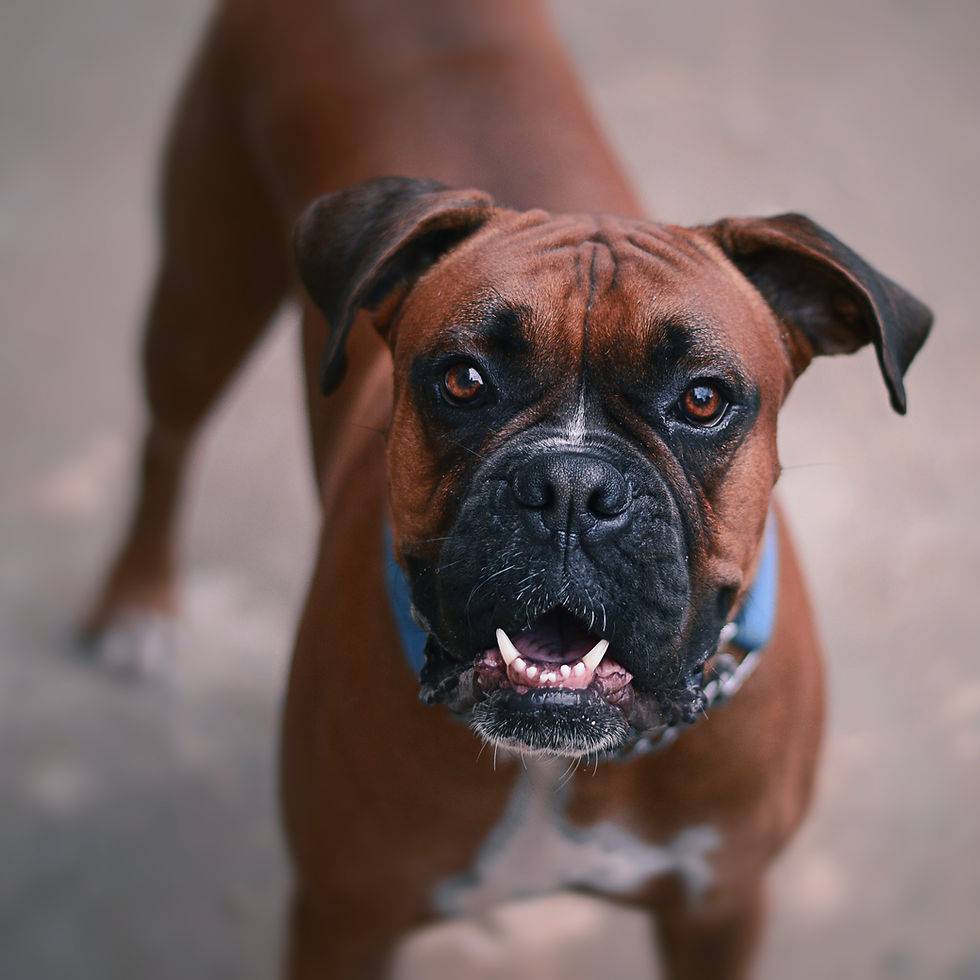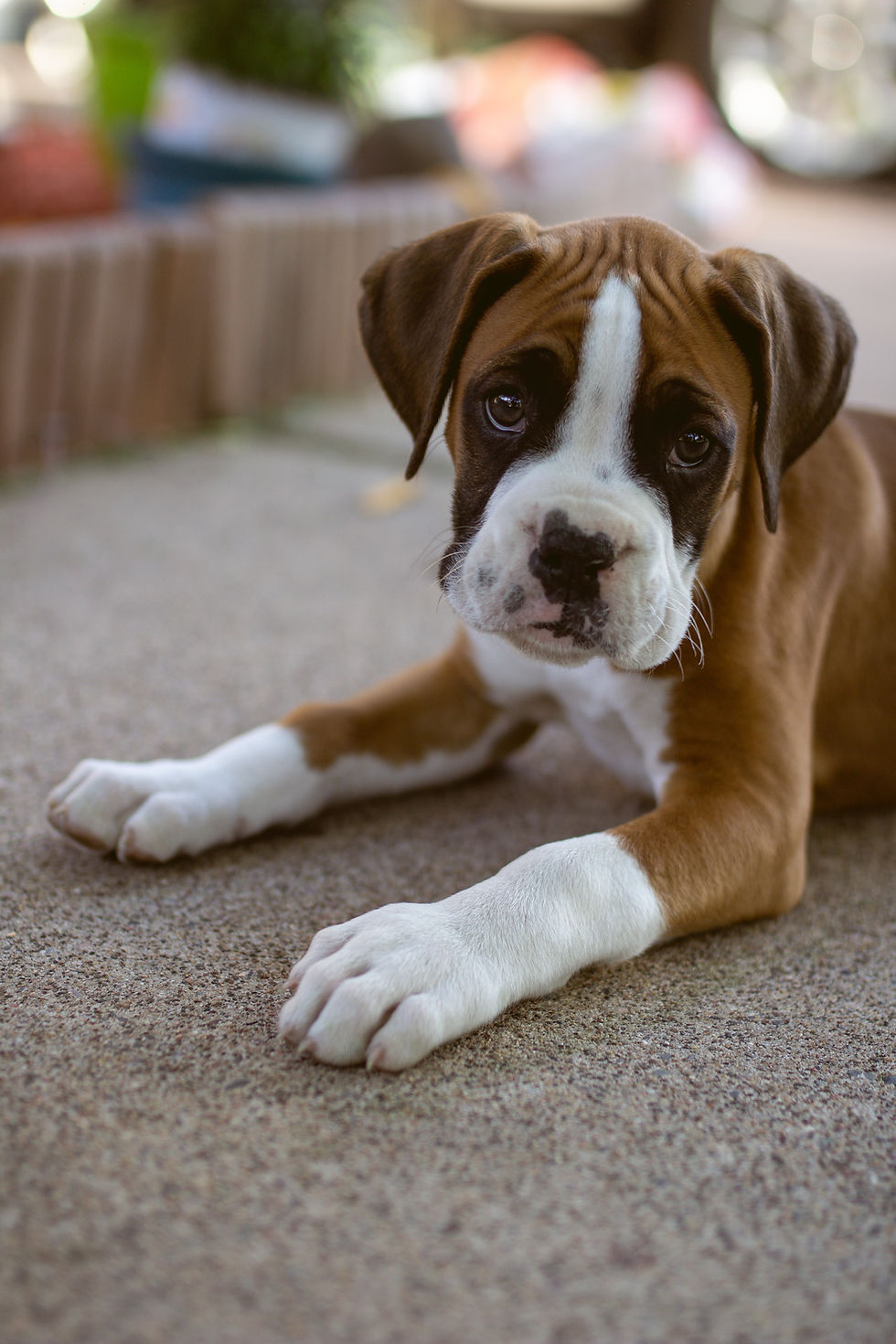Is A Boxer Right For You?
- mustluvboxersrescu

- Sep 1, 2020
- 4 min read

If you’re looking for an high energy, easy-to-groom, family friendly pooch, the boxer may be the perfect breed for you. Boxers are athletic, quite intelligent, and love to clown around. They often get along very well with children and possess an instinct to protect the family, making them wonderful family dogs.
While not all boxers are droolers, some drool excessively. Others snore louder than a freight train and some don’t let out a peep while they sleep. And all boxers can successfully out wiggle a human on any given day!
HISTORY
The Boxer's ancestors were the German Bullenbeisser (literally bull-biter, a dog that descended from Mastiffs) and the Olde English Bulldog. The Bullenbeisser was used as a hunting dog for centuries to hunt bear, wild boar, and deer. Its task was to catch and hold the prey until hunters arrived. Over time, they began to be used by farmers and butchers to guard and drive cattle.
The Boxer breed we know today was developed in the late 19th century in Germany. In 1894, three Germans decided to stabilise the breed and put it on exhibition at a dog show. This was done in Munich in 1895, and the next year they founded the first Boxer Club.
The breed became known in other parts of Europe in the late 1890s. Around 1903, the first Boxers were imported into the U.S. When World War I broke out, Boxers were enlisted into the military, serving as messenger dogs, carrying packs, and acting as attack and guard dogs.
Boxers started becoming popular in the U.S. in the 1940s when soldiers coming home from World War II brought their boxer mascots with them. Through them, the breed was introduced to more people and soon became a favourite as a companion animal, show dog, and guard dog.
APPEARANCE

Boxers are the tallest member of the Brachycephalics: those breeds are distinguished by their short snouts and undershot jaws such as the Pugs and French Bulldogs. Breeders say the development of this undershot jaw was encouraged as it was believed to be better suited to holding its prey.
A medium-sized dog, slightly taller than an Australian Cattle Dog, the boxer has a smooth, sleek coat. The #boxer is a sturdy dog of short square figure and strong limb. Boxers have a strong, well-muscled physique with a broad chest and barrel-like forequarter tapering to a narrow hindquarter.
The recognized colors are fawn and brindle, frequently with a white underbelly and white on the feet. These white markings, called "flash", often extend onto the neck or face, and dogs that have these markings are known as "flashy".
Brindle typically has a striking tiger-striped pattern and the fawn color is a solid medium color brown to brownish red. White markings usually appear on the belly or feet and shouldn't cover more than one-third of the coat.
Boxers with white markings covering more than one-third of their coat – conventionally called "white" boxers – are neither albino nor rare; approximately 20–25% of all boxers born are white. Genetically, these dogs are either fawn or brindle, with excessive white markings over the base coat color. Like fair-skinned humans, white boxers have a higher risk of sunburn and associated skin cancers.
Height: Males grow to about 25 inches; Females 21-25 inches
Weight: Males 65-80 lbs; Females: 50-65 lbs
Life Expectancy: 8-12 years
TEMPERAMENT
Fearless and self-assured, the boxer is instantly recognizable, with its jowly, square face and stocky build. This is a lively dog, bouncy and #energetic and be prepared for your Boxer to take up to two years plus to fully mature. Hint hint: this is why we call them the perpetual teenagers of the dog world!
Most boxers make vigilant watchdogs - meaning they will bark when they see or hear something out of the ordinary. Their guarding and territorial instincts, though, vary a great deal. Most Boxers react to strangers with a joyous "Hi there! Come on in!" (often accompanied by enthusiastic jumping and tail-wagging). Other boxers are more stoic and polite with strangers.
Because boxers are extremely loyal to their families and feel a deep attachment to their people, separation anxiety can develop. Proper levels of physical activity and mental activity can keep separation anxiety from becoming a problem. TRAINING & EXERCISE

Boxers have an independent mind of their own and are not pushovers to raise and train. Many boxers are passively stubborn and will brace their legs or look the other way and refuse to do what you want them to do. Some are dominant and will make you prove your “Alpha” status. Just know going in, that structure and training are the magic keys to your success.
Boxers can be hyperactive and unruly if not properly exercised. This is simply a result of their big, loving personalities and their need to socialize. To curb their natural exuberance for jumping and a fly-by kiss or two, make sure your boxer gets a significant amount of exercise every day. Exercise needs vary but your typical boxer needs a 30-minute walk twice daily and a rousing game of fetch. A large backyard is ideal and high fences are a must as boxers are notorious jumpers and/or escape artists.
COMMON HEALTH PROBLEMS
Responsible breeders strive to maintain the highest breed standards as established by kennel clubs like the American Kennel Club (AKC). Dogs bred by these standards are less likely to inherit health conditions. However, some hereditary health problems can occur in the breed. Remember that regular veterinary check-ups are an important part of keeping your dog healthy. Your vet may be able to detect the early signs of health problems before they affect your dog.
The following are some health conditions that may affect boxers:
Cancer: Boxers are prone to several types of cancer, including mast cell tumors, lymphoma, and skin cancer.
Aortic stenosis: This narrowing of the aorta causes the heart to work harder. It is a genetic condition and dogs with it should not be bred. It can cause fainting and sudden death.
Dilated cardiomyopathy: This is also an inherited condition of an irregular heartbeat. Boxers with this condition should not be bred. The boxer may show fainting and sudden death.
As with any breed, if you think the boxer is the dog for you, do plenty of research before you get one. Talk to veterinarians, other owners, reputable breeders, and Boxer Rescue groups to learn more.




